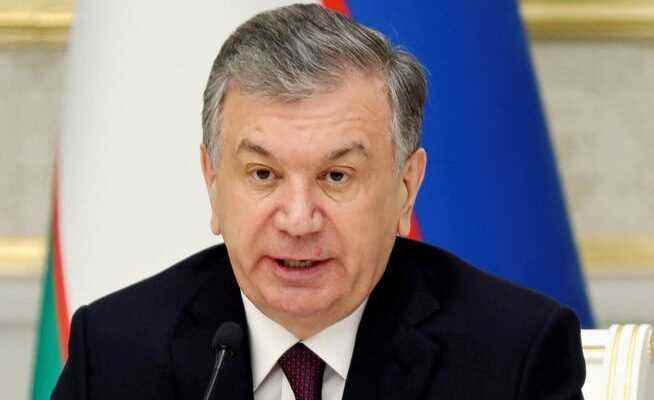In the autonomous republic of Karakalpakstan, residents demonstrated against the curtailment of political rights in their region. President Mirziyoyev withdrew the controversial measures. The crisis threatens Uzbekistan’s stability.
Uzbekistan’s President Shavkat Mirsiyoyev (archive photo from 2019).
Karakalpakstan is a forgotten region in western Uzbekistan, covering a third of the Central Asian state. Now the sparsely populated, desert-like republic with the capital Nukus is suddenly in the world media. Not because of the drying up of the Aral Sea, the Uzbek part of which belongs to Karakalpakstan, but because of severe political turmoil.
Thousands of residents have taken to the streets in Nukus and other places in the region over the past few days to protest against the curtailment of their autonomy within Uzbekistan. On Saturday, the authorities declared a month-long state of emergency over Karakalpakstan. They closed border crossings to neighboring Kazakhstan and restricted access to larger towns.
Uzbek President Shavkat Mirziyoyev confirmed in Nukus on Sunday that there had been deaths and injuries among demonstrators and security forces. The damage in the city is considerable. He tried to calm the situation with concessions.
Blocked information paths
The security forces, which had been hastily reinforced by parts of the national guard, apparently used violence against the participants in the peaceful demonstrations on Saturday, according to videos, images and reports from Karakalpakstan. Confusion was caused by video footage of what appeared to be pools of blood on the streets of Nuku. This was explained with colored liquid from police water cannons. Security forces use this to mark demonstrators who can later be identified from the traces of paint. Such an approach is also known from other countries.
1. Uzbekistan: President Mirziyoyev confirms dead among peaceful civilians, security officers. He says protesters did not stop despite warnings, committed series of violent acts July 2. Clashes with security, armed attempts to overtake buildings, attacks on public property. pic.twitter.com/qaCWwVxFJr
— Navbahor Imamova (@Navbahor) July 3, 2022
Because the authorities have almost completely blocked telephony and the Internet, it is very difficult to get a clear picture of the situation. Officially, there was talk of numerous arrests. The fact that Dauletmurat Taschimuratov, a popular blogger and political activist, was arrested also apparently contributed to the escalation. He had called for a peaceful rally on Tuesday evening and, according to reports from Nukus, also appeared in front of the crowd with the Speaker of Karakalpakstan Parliament.
President Mirsiyoyev announced in Nukus that he would refrain from encroaching on Karakalpakstan’s autonomy as a result of the recently published constitutional amendments. Information about this was sent to the population via SMS.
worry about stability
In doing so, he is trying to avoid a chain reaction, such as dissatisfaction spreading to other parts of Uzbekistan and destabilizing the already tense socio-economic situation in the Central Asian republic.
Some commentators have already whispered about Mirsijoyev’s “Andijan”: In May 2005, his predecessor, the long-term despotic ruler Islam Karimov, bloodily suppressed protests in the southern part of the country, in the city of Andijan in the Fergana Valley – on the pretext that Islamists were threatening them Republic. He had been isolated internationally for years.
The events cannot be equated, and Mirzijoyev, who since coming to power in 2016 has wanted to lead Uzbekistan into a modern, cosmopolitan future, is not Karimov. But the protests of the past few days have been far-reaching greater than previous expressions of displeasure, which mostly broke out because of local grievances. Instead of confronting the root causes, speak the authorities of Karakalpakstan however, from the attempt at violent overthrow in Nukus, which could be foiled. And from outside, unspecified forces that would have stirred up the population.
Constitutional amendment as a starting point
The crisis was conjured up by the officials in the capital, Tashkent. The economically dependent region, inhabited mostly by Karakalpaks and Kazakhs, had previously enjoyed the status of a sovereign autonomous republic in the constitution. This meant that the regional parliament in Nukus could, at least formally, pass its own laws and influence conditions in Karakalpakstan.
Now, in the course of constitutional amendments, Mirziyoyev and his followers wanted primarily intended to enable the president to remain in power, downgrade Karakalpakstan to an ordinary Uzbek province. This hit a population that already felt neglected and plagued by serious environmental problems. In response to the protests, Mirsiyoyev not only boasted about the progress made in parts of the region in recent years. He also expressed contrition, claiming that the proposals for amending the constitution came from the Karakalpak people.
After the collapse of the Soviet Union, the constituent republic was also given the right, at least in theory, to hold a vote on secession from the rest of the country. Karakalpakstan had been administered directly by Moscow for a number of years after the founding of the Soviet Union from 1924. Later it was first added to the Kazakh and only in 1936 to the Uzbek Soviet Republic. As everywhere in the region, these allocations of areas and demarcations were done arbitrarily, without regard to historical and cultural circumstances.
